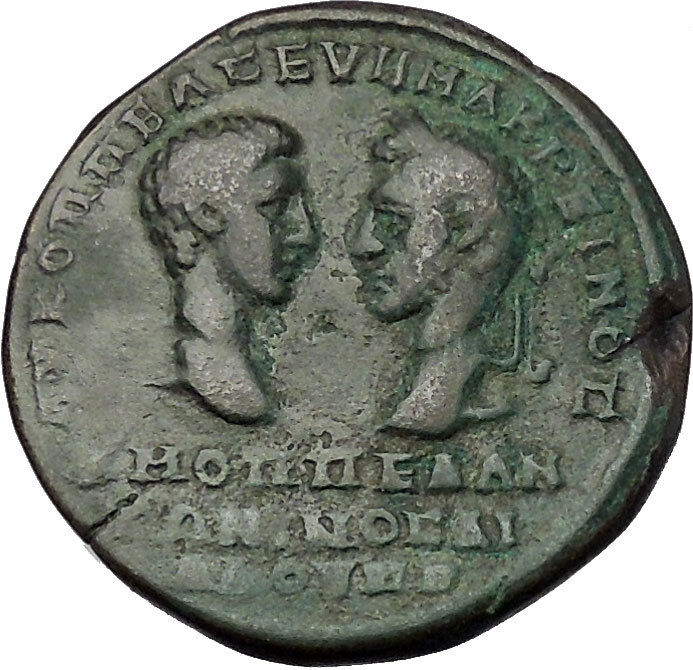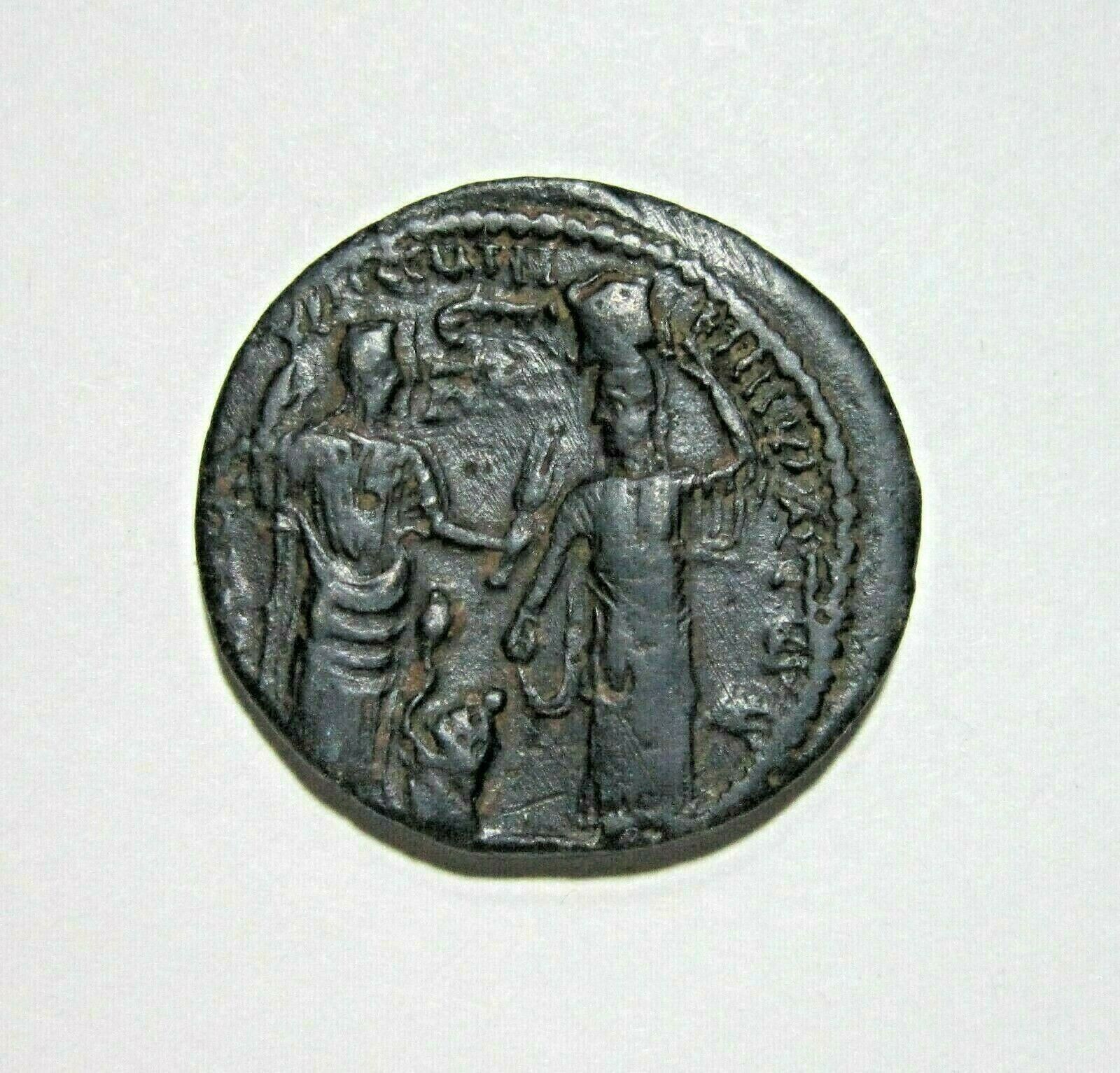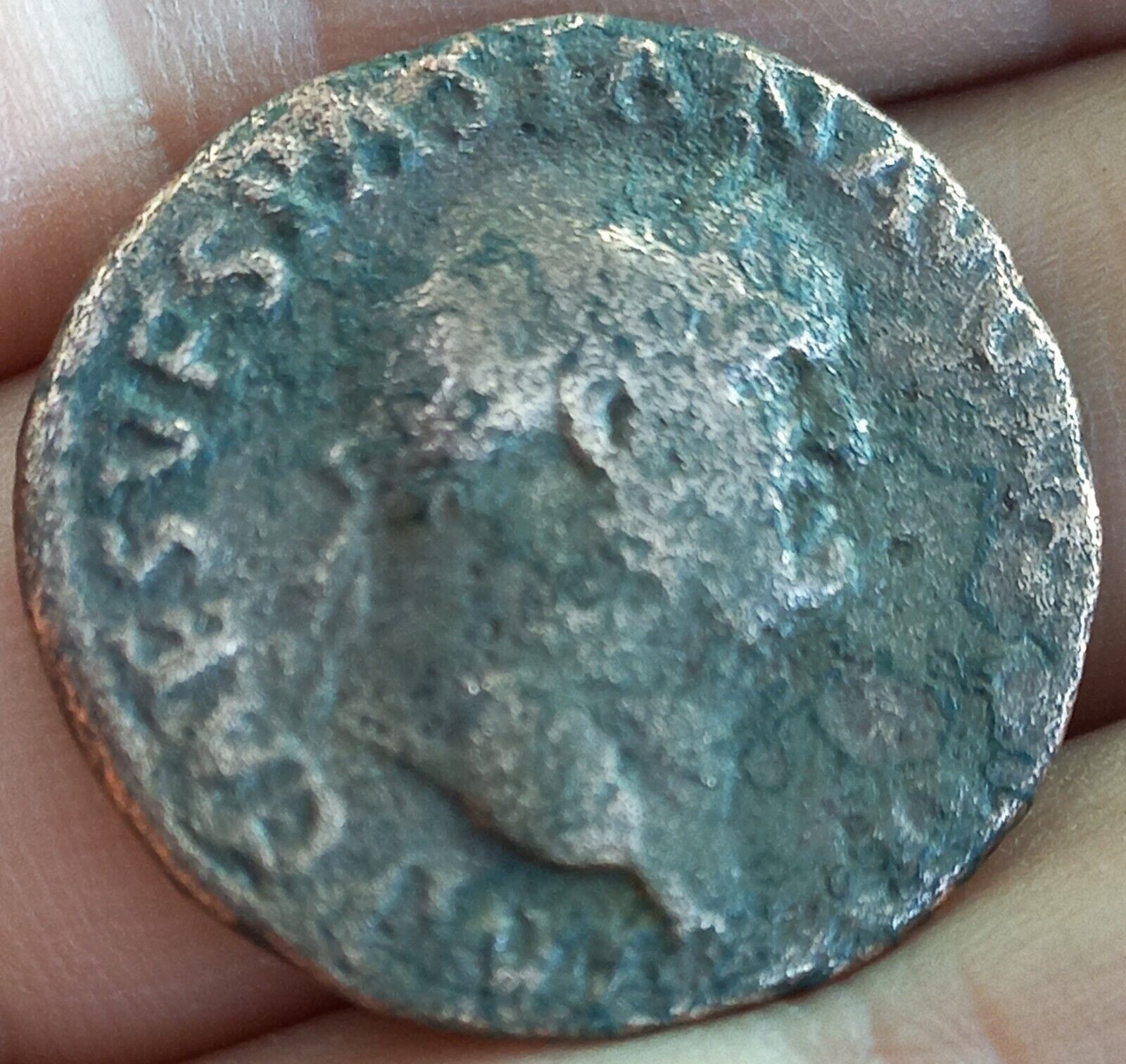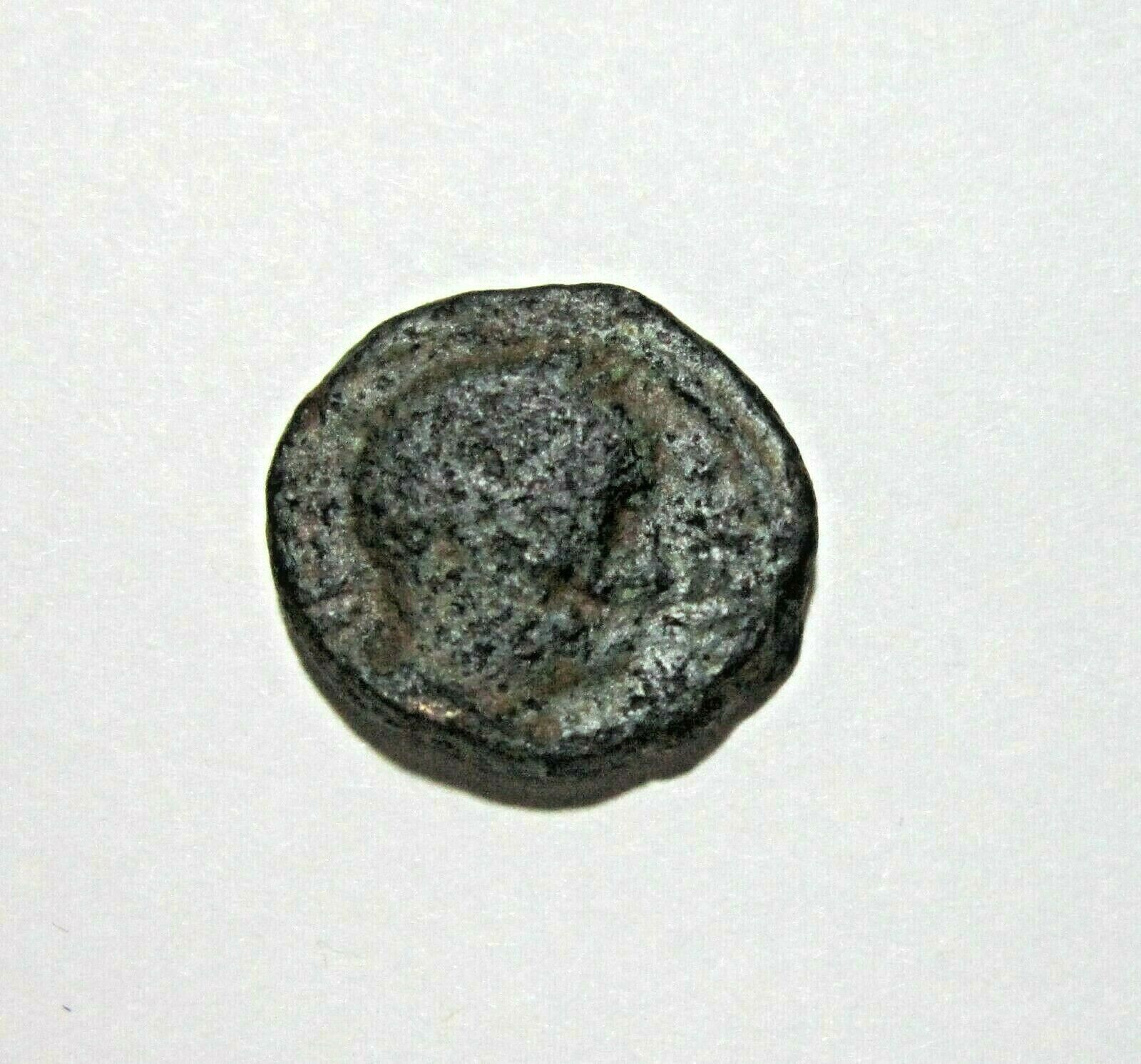-40%
MACRINUS and DIADUMENIAN 217AD Marcianopolis HERCULES Rare Roman Coin i50936
$ 264
- Description
- Size Guide
Description
Item:i50936
Authentic Ancient Coin of:
Macrinus
-
Roman Emperor
: 217-218 A.D. -
Bronze 26mm (12.05 grams) of
<="" font="" face="Times New Roman" color="#000000"> Marcianopolis in Moesia Inferior under Legate Furius Pontianus
AV K OΠΠEΛ CEVH MAKPEINOC K M OΠΠEΛ ANTΩNINOC
ΔΙΑΔΟVΜΗ, Bare head of Diadumenian on left facing right towards laureate head of his father, Macrinus, facing left on right.
VΠ ΠONTIANOV MAPKIANOPOΛEITΩN,
Nude Hercules
You are bidding on the exact item pictured, provided with a Certificate of Authenticity and Lifetime Guarantee of Authenticity.
Hercules
is the Roman name for the Greek
divine
hero
Heracles
, who was the son of
Zeus
(Roman equivalent
Jupiter
) and the mortal
Alcmene
. In
classical mythology
, Hercules is famous for his strength and for his numerous far-ranging adventures.
The Romans adapted the Greek hero's iconography and myths for their literature and art under the name
Hercules
. In later
Western art
and literature and in
popular culture
,
Hercules
is more commonly used than
Heracles
as the name of the hero. Hercules was a multifaceted figure with contradictory characteristics, which enabled later artists and writers to pick and choose how to represent him. This article provides an introduction to representations of Hercules in the
later tradition
.
Labors of Hercules
Hercules is known for his many adventures, which took him to the far reaches of the
Greco-Roman world
. One cycle of these adventures became
canonical
as the "Twelve Labours," but the list has variations. One traditional order of the labours is found in the
Bibliotheca
as follows:
Slay the
Nemean Lion
.
Slay the nine-headed
Lernaean Hydra
.
Capture the
Golden Hind of Artemis
.
Capture the
Erymanthian Boar
.
Clean the
Augean
stables in a single day.
Slay the
Stymphalian Birds
.
Capture the
Cretan Bull
.
Steal the
Mares of Diomedes
.
Obtain the girdle of
Hippolyta
, Queen of the
Amazons
.
Obtain the cattle of the monster
Geryon
.
Steal the apples of the
Hesperides
.
Capture and bring back
Cerberus
.
The
Latin
name
Hercules
was borrowed through
Etruscan
, where it is represented variously as
Heracle
, Hercle, and other forms. Hercules was a favorite subject for
Etruscan art
, and appears often on
bronze mirrors
. The Etruscan form
Herceler
derives from the Greek
Heracles
via
syncope
. A mild oath invoking Hercules (
Hercule!
or
Mehercle!
) was a common
interjection
in
Classical Latin
.
Baby Hercules strangling a
snake
sent to
kill him in his
cradle
(Roman marble, 2nd century CE)
Hercules had a number of
myths
that were distinctly Roman. One of these is Hercules' defeat of
Cacus
, who was terrorizing the countryside of Rome. The hero was associated with the
Aventine Hill
through his son
Aventinus
.
Mark Antony
considered him a personal patron god, as did the emperor
Commodus
. Hercules received various forms of
religious veneration
, including as a
deity concerned with children and childbirth
, in part because of myths about his precocious infancy, and in part because he fathered countless children. Roman brides wore a special belt tied with the "
knot of Hercules
", which was supposed to be hard to untie. The comic playwright
Plautus
presents the myth of Hercules' conception as a sex comedy in his play
Amphitryon
;
Seneca
wrote the tragedy
Hercules Furens
about his bout with madness. During the
Roman Imperial era
, Hercules was worshipped locally from
Hispania
through
Gaul
.
Medieval mythography
After the Roman Empire became
Christianized
, mythological narratives were often reinterpreted as
allegory
, influenced by the philosophy of
late antiquity
. In the 4th century,
Servius
had described Hercules' return from the underworld as representing his ability to overcome earthly desires and vices, or the earth itself as a consumer of bodies. In medieval mythography, Hercules was one of the heroes seen as a strong role model who demonstrated both valor and wisdom, with the monsters he battles as moral obstacles. One
glossator
noted that when
Hercules became a constellation
, he showed that strength was necessary to gain entrance to Heaven.
Medieval mythography was written almost entirely in Latin, and original Greek texts were little used as sources for Hercules' myths.
Renaissance mythography
The
Renaissance
and the invention of the
printing press
brought a renewed interest in and publication of Greek literature. Renaissance mythography drew more extensively on the Greek tradition of Heracles, typically under the Romanized name Hercules, or the alternate name
Alcides
. In a chapter of his book
Mythologiae
(1567), the influential mythographer
Natale Conti
collected and summarized an extensive range of myths concerning the birth, adventures, and death of the hero under his Roman name Hercules. Conti begins his lengthy chapter on Hercules with an overview description that continues the moralizing impulse of the Middle Ages:
Hercules, who subdued and destroyed monsters, bandits, and criminals, was justly famous and renowned for his great courage. His great and glorious reputation was worldwide, and so firmly entrenched that he'll always be remembered. In fact the ancients honored him with his own temples, altars, ceremonies, and priests. But it was his wisdom and great soul that earned those honors; noble blood, physical strength, and political power just aren't good enough.
Marcianopolis
, or
Marcianople
was an ancient Roman city in
Thracia
. It was located at the site of modern day
Devnya
,
Bulgaria
.
The city was so renamed by Emperor
Trajan
Ulpia Marciana
, and was previously known as Parthenopolis. Romans repulsed a
Gothic
attack to this town in
267
(or
268
), during the reign of
Gallienus
.
Diocletian
made it the capital of the
Moesia Secunda
province.
Valens
made it his winter quarters in 368 and succeeding years, Emperor
Justinian I
restored and fortified it. In 587, it was sacked by the king of the
Avars
but at once retaken by the Romans. The Roman army quartered there in 596 before crossing the Danube to assault the Avars.
Between 893 and 972 it was one of the most important medieval cities in south-eastern Europe.
Marcus Opellius Antoninus Diadumenianus
or
Diadumenian
(208–218) was the son of the Roman Emperor Macrinus, and served his father briefly as Caesar (May 217–218) and as Augustus (in 218). Diadumenian was born in 14th of September 208 a.C or according to Historia Augusta in 19th of September 208 a.C because he shared the same birthday with the emperor Antoninus Pius. His mother was Empress Nonia Celsa, although her existence remains dubious, because she was only mentioned by the Historia Augusta. He was born Marcus Opellius Diadumenianus, but his name was changed and added Antoninus to solidify connection to the family of Marcus Aurelius as done by Caracalla.
Diadumenian had little time to enjoy his position or to learn anything from its opportunities because the legions of Syria revolted and declared Elagabalus ruler of the Roman Empire. When Macrinus was defeated on June 8, 218, at Antioch, Diadumenian followed his father's death.
Marcus Opellius Macrinus
(ca. 165 - June 218) was
Roman
emperor
for fourteen months in 217 and 218. Macrinus was the first emperor to become so without membership in the senatorial class. Macrinus was possibly of
Berberr
descent.
//
Background and career
Born in Caesarea (modern
Cherchell
, Algeria) in the
Roman province
of
Mauretania
to an
equestrian
family, Macrinus received an education which allowed him to ascend to the Roman political class. Over the years he earned a reputation as a skilled lawyer. Under the emperor
Septimius Severus
he became an important bureaucrat. Severus' successor
Caracalla
appointed him
prefect
of the
Praetorian guard
. While Macrinus likely enjoyed the trust of Caracalla, this may have changed when, according to tradition, he was prophesied to depose and succeed the emperor. Rumors spread regarding Macrinus' alleged desire to take the throne for himself. Given Caracalla's tendency towards murdering political opponents, Macrinus probably feared for his own safety should the emperor become aware of this prophecy. According to Dio, Caracalla had already taken the step of re-assigning members of Macrinus' staff.
In the spring of 217, Caracalla was in the eastern provinces preparing a campaign against the
Parthian Empire
. Macrinus was among his staff, as were other members of the praetorian guard. In April, the emperor went to visit a temple of
Luna
near the spot of the
battle of Carrhae
, accompanied only by his personal bodyguard, which included Macrinus. Events are not clear, but it is certain that Caracalla was murdered at some point on the trip (perhaps on
April 8
). Caracalla's body was brought back from the temple by his bodyguards, along with the corpse of a fellow bodyguard. The story as told by Macrinus was that the dead guard had killed Caracalla. By
April 11
, Macrinus proclaimed himself emperor. Macrinus also nominated his son
Diadumenianus
Caesar
and successor and conferred upon him the name "Antoninus", thus connecting him with the relatively stable reigns of the
Antonine emperors
of the 2nd century.
Reign (April 217 - June 218)
Despite his equestrian background, Macrinus was confirmed in his new role by the
Senate
. According to S.N. Miller, this may have been due to both his background as an accomplished jurist and his deferential treatment of the senatorial class. He found it necessary, however, to replace several provincial governors with men of his own choosing. Caracalla's mother
Julia Domna
was initially left in peace, but when she started to conspire with the military he ordered her to leave
Antioch
. Being at that time in an advanced stage of breast cancer (Cassius Dio) she chose instead to starve herself to death.
In urgent matters of foreign policy, Macrinus displayed a tendency towards conciliation and a reluctance to engage in military conflict. He averted trouble in the province of
Dacia
by returning hostages that had been held by Caracalla, and he ended troubles in
Armenia
by granting that country's throne to
Tiridates
, whose father had also been imprisoned under Caracalla. Less easily managed was the problem of
Mesopotamia
, which had been invaded by the
Parthians
in the wake of Caracalla's demise. Meeting the Parthians in battle during the summer of 217, Macrinus achieved a
costly draw
near the town of
Nisibis
and as a result was forced to enter negotiations through which was obliged to pay the enormous
indemnity
of 200 million sesterces to the Parthian ruler
Artabanus IV
in return for peace.
Macrinus' reluctance to engage in warfare, and his failure to gain victory over even a historically inferior enemy such as the Parthians caused considerable resentment among the soldiers. This was compounded by the rolling back of the privileges they had enjoyed under Caracalla and the introduction of a pay system by which recruits received less than veterans. After only a short while, the legions were searching for a rival emperor.
At a high point of his popularity monuments were built to revere Macrinus. The grand
tetrastyle
Capitoline Temple
, in
Volubilis
was erected to honour Emperor Macrinus in 217 AD.
His popularity also suffered in Rome. Not only had the new emperor failed to visit the city after taking power, but a late-summer thunderstorm caused widespread fires and flooding, and Macrinus' appointee as urban prefect proved unable to repair the damage to the satisfaction of the populace and had to be replaced.
Downfall
This discontent was fostered by the surviving members of the
Severan dynasty
, headed by
Julia Maesa
(Caracalla's aunt) and her daughters
Julia Soaemias
and
Julia Mamaea
. Having been evicted from the imperial palace and ordered to return home by Macrinus, the Severan women plotted from their home near
Emesa
in
Syria
to place another Severan on the imperial throne. They used their hereditary influence over the cult of
sun-deity
Elagabalus (the Latinised form of
El-Gabal
) to proclaim Soaemias' son
Elagabalus
(named for his family's patron deity) as the true successor to Caracalla. The rumor was spread, with the assistance of the Severan women, that Elagabalus was in fact Caracalla's illegitimate son, and thus the child of a union between first cousins.
On
May 18
, Elagabalus was proclaimed emperor by the
Gallica
Legio III
at its camp at
Raphana
. A force under his tutor Gannys marched on
Antioch
and engaged a force under Macrinus on
June 8
,
218
. Macrinus, deserted by most of his soldiers, was soundly defeated in the
battle
, and fled towards Italy disguised as a courier. He was captured near
Chalcedon
and later executed in
Cappadocia
. His son Diadumenianus, sent for safety to the Parthian court, was captured at
Zeugma
and also put to death.
Macrinus' short reign, while important for its historical "firsts", was cut short due to the inability of this otherwise accomplished man to control or satisfy the soldiery. In his death at the hands of Roman soldiers, Macrinus reinforced the notion of the soldiers as the true brokers of power in the third-century empire and highlighted the importance of maintaining the support of this vital faction. His reign was followed by another seventeen years of rule under the Severan emperors
Elagabalus
and
Severus Alexander
.
="">
Frequently Asked Questions
How long until my order is shipped?:
Depending on the volume of sales, it may take up to 5 business days for shipment of your order after the receipt of payment.
How will I know when the order was shipped?:
After your order has shipped, you will be left positive feedback, and that date should be used as a basis of estimating an arrival date.
After you shipped the order, how long will the mail take?
USPS First Class mail takes about 3-5 business days to arrive in the U.S., international shipping times cannot be estimated as they vary from country to country. I am not responsible for any USPS delivery delays, especially for an international package.
What is a certificate of authenticity and what guarantees do you give that the item is authentic?
Each of the items sold here, is provided with a Certificate of Authenticity, and a Lifetime Guarantee of Authenticity, issued by a world-renowned numismatic and antique expert that has identified over 10000 ancient coins and has provided them with the same guarantee. You will be quite happy with what you get with the COA; a professional presentation of the coin, with all of the relevant information and a picture of the coin you saw in the listing.
Compared to other certification companies, the certificate of authenticity is a -50 value. So buy a coin today and own a piece of history, guaranteed.
Is there a money back guarantee?
I offer a 30 day unconditional money back guarantee. I stand behind my coins and would be willing to exchange your order for either store credit towards other coins, or refund, minus shipping expenses, within 30 days from the receipt of your order. My goal is to have the returning customers for a lifetime, and I am so sure in my coins, their authenticity, numismatic value and beauty, I can offer such a guarantee.
Is there a number I can call you with questions about my order?
You can contact me directly via ask seller a question and request my telephone number, or go to my About Me Page to get my contact information only in regards to items purchased on eBay.
When should I leave feedback?
Once you receive your order, please leave a positive. Please don't leave any negative feedbacks, as it happens many times that people rush to leave feedback before letting sufficient time for the order to arrive. Also, if you sent an email, make sure to check for my reply in your messages before claiming that you didn't receive a response. The matter of fact is that any issues can be resolved, as reputation is most important to me. My goal is to provide superior products and quality of service.










